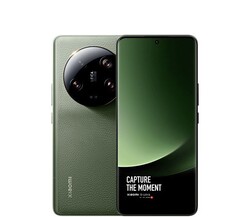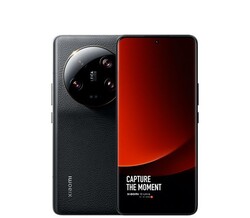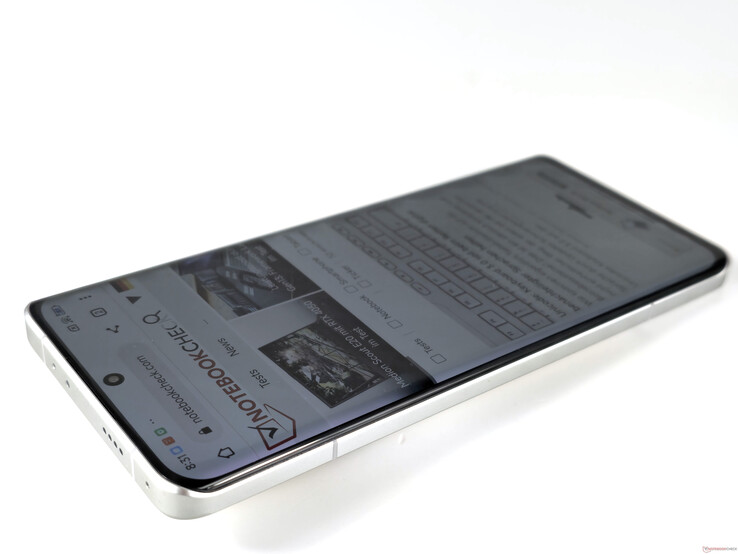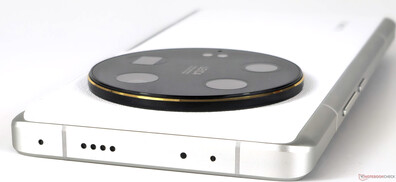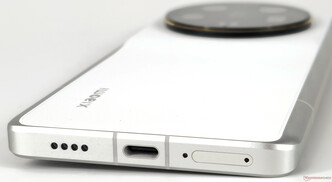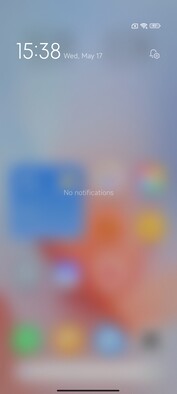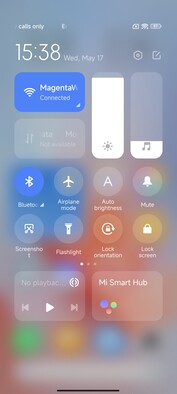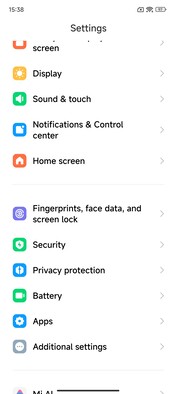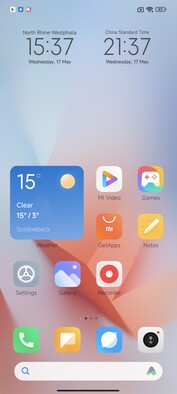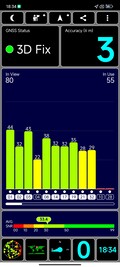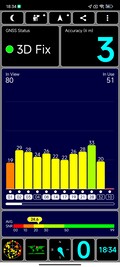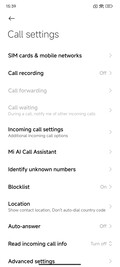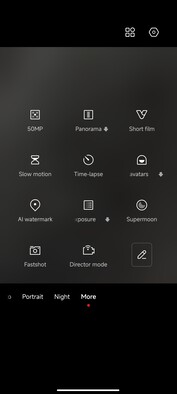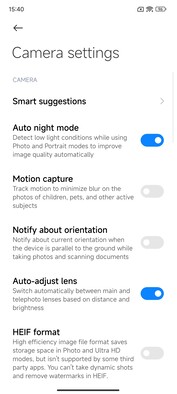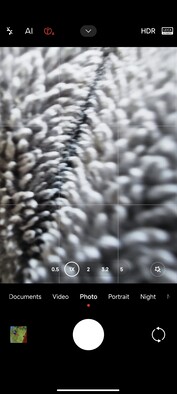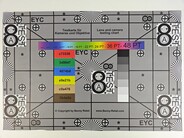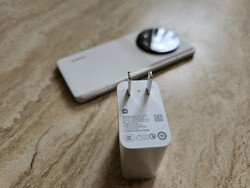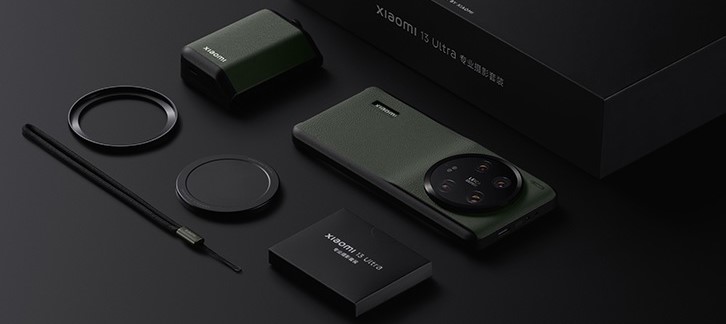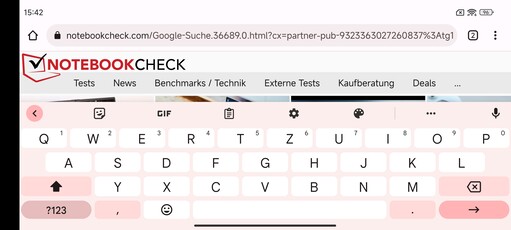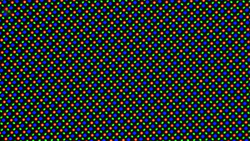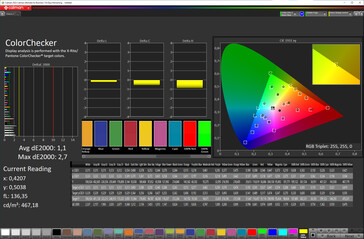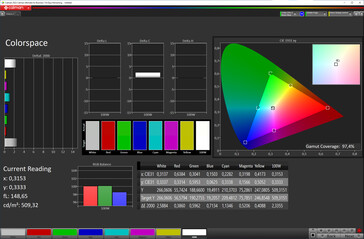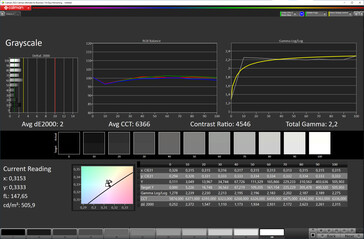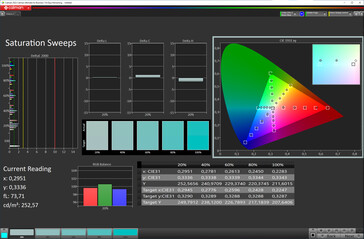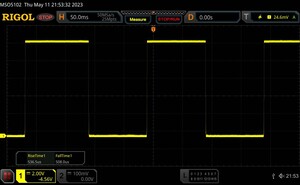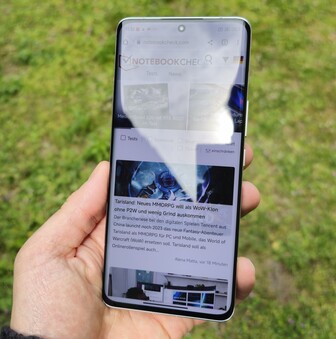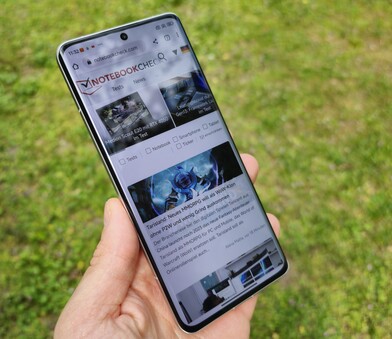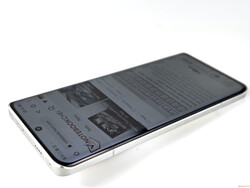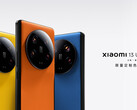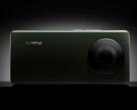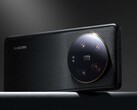Xiaomi 13 Ultra review - Spectacular smartphone with variable camera aperture for Leica fans
The Xiaomi 13 Ultra is a logical development of the premium smartphone series from the Chinese manufacturer. In addition to a high-quality Leica Summicron lens together with its 1-inch Sony sensor from the Pro model, the camera flagship, which was developed in cooperation with Leica, is able to bring some improvements in the area of macro photography – at least according to the spec sheet. In addition, the weaknesses of the Xiaomi 13 Pro, such as the slow USB 2.0 data transfer standard, have now been overcome with the Ultra model.
Otherwise, the two premium smartphones from Xiaomi are visually and technically very similar. The Ultra model also offers a large and fast 6.73-inch 120-Hz QHD+ AMOLED display and a Qualcomm Snapdragon 8 Gen 2. In terms of the price, the Chinese version of the Xiaomi 13 Ultra is already available from international importers starting from around 1,000 Euros (~$1,106). However, Xiaomi already confirmed that the flagship smartphone will also come on the market in Europe, but there are no details on the price or availability date yet.
Possible Competitors in Comparison
Rating | Date | Model | Weight | Drive | Size | Resolution | Price |
|---|---|---|---|---|---|---|---|
| 89.7 % v7 (old) | 06 / 2023 | Xiaomi 13 Ultra SD 8 Gen 2, Adreno 740 | 227 g | 512 GB UFS 4.0 Flash | 6.73" | 3200x1440 | |
| 88.8 % v7 (old) | 09 / 2022 | Xiaomi 12S Ultra SD 8+ Gen 1, Adreno 730 | 225 g | 256 GB UFS 3.1 Flash | 6.73" | 3200x1440 | |
| 91.1 % v7 (old) | 03 / 2023 | Samsung Galaxy S23 Ultra SD 8 Gen 2 for Galaxy, Adreno 740 | 233 g | 256 GB UFS 4.0 Flash | 6.80" | 3080x1440 | |
| 89.1 % v7 (old) | 11 / 2022 | Google Pixel 7 Pro Tensor G2, Mali-G710 MP7 | 212 g | 128 GB UFS 3.1 Flash | 6.70" | 3120x1440 | |
| 89.4 % v7 (old) | 05 / 2023 | Motorola Edge 40 Pro SD 8 Gen 2, Adreno 740 | 199 g | 256 GB UFS 4.0 Flash | 6.67" | 2400x1080 |
Case - Xiaomi 13 Ultra with IP Rating
The Xiaomi 13 Ultra can be purchased in three different color variants and a limited color edition, with all models having the vegan leather texture on the back in common. The material feels comfortable in the hand and is supposed to be wear-resistant and resistant to yellowing according to the manufacturer. It is also supposed to have an antibacterial certification. In terms of quality, the leather imitation might possibly represent a step back for owners of the European predecessor, the Xiaomi Mi 11 Ultra with its ceramic surface. But at least greasy finger smudges are hidden well by the textured surface. The metal frames of all color variants are matte and have the corresponding color.
With the huge camera element, the weight distribution of the premium smartphone is quite top-heavy, just like the predecessor, particularly since the case is also slightly thicker in the area of the camera lenses. With a weight of 227 grams (~8 oz), the flagship from the Chinese manufacturer is also no lightweight. The quality of the Xiaomi 13 Ultra workmanship is excellent, and the gaps are flush and even. In addition, the case is IP68 certified and is therefore waterproof.
The AMOLED display in front is protected by Corning Gorilla Glass Victus of the first generation. The display bezels are small, resulting in a screen-to-body ratio of 89.5%.
Equipment - Xiaomi smartphone with up to 1 TB storage
The USB-2.0 era of the Xiaomi smartphones came to an end with the 13 Ultra, and the flagship from the Chinese manufacturer now offers the fast USB 3.2 (Gen. 1) standard, which also supports USB-OTG in addition to the wired image output to HDMI or DisplayPort connections. In our copy test using a connected M2.SSD drive (Samsung 980 Pro), the USB port reaches fairly high transfer rates of 461 MB/s – with data rates of up to 5 Gbit/s for transfer of photos and videos being theoretically possible. The premium smartphone from Xiaomi is offered in three different versions in China:
Xiaomi 13 Ultra | 12 GB LPDDR5x-RAM | 256 GB UFS 4.0 storage
Xiaomi 13 Ultra | 16 GB LPDDR5x-RAM | 512 GB UFS 4.0 storage
Xiaomi 13 Ultra | 16 GB LPDDR5x-RAM | 1 TB UFS 4.0 storage.
With Bluetooth 5.3, NFC, an IR blaster, and Miracast, the Xiaomi 13 Ultra otherwise also offers an almost complete equipment package.
Software - Xiaomi 13 Ultra with MIUI
At the time of this test, the operating system of the Xiaomi 13 Ultra is based on Android 13 with the security patch level from April 2023. The Chinese manufacturer adds an overlay of the in-house MIUI version 14. The update warranty of the global Xiaomi smartphones from the premium segment has now been expanded to five years of security updates and three large Android updates. While this is an important step in the right direction, buyers of a Galaxy S23 Ultra will still get longer support with four large Android updates.
As in the other Chinese versions of the Xiaomi smartphones, the in-house software of the 13 Ultra doesn't support Google services such as the PlayStore in the state of delivery. Instead, Chinese services and Xiaomi's own services are used. However, the Google Frameworks are already preinstalled in the state of delivery, so that you only have to install the PlayStore manually.
Note: TradingShenzhen, who provided our test unit to us, also offers the option to purchase the Xiaomi 13 Ultra with the Xiaomi.EU ROM, which is based on the Chinese firmware but expands the language selection (also including German) and natively adds the Google Services.
Communication and GNSS - Xiaomi smartphone with 5G
The Xiaomi 13 Ultra supports all the current mobile communication standards including 5G Sub6 with the exception of 5G mmWave. While with 17 LTE bands, the frequency coverage is also satisfactory with our Chinese version, the import device differs in some details from a global version expected in Europe. For example, the Xiaomi 13 Ultra that was designed for the Chinese market lacks the support for several European LTE bands such as band 20 and 28, which might create some connectivity problems for some users in this country (Germany).
Where the Chinese version doesn't differ from the global version is the WLAN support. With WiFi 7, the Xiaomi 13 Ultra offers lightning-fast transfer rates, but even with our WiFi 6E Asus ROG Rapture GT-AXE11000 reference router, the Xiaomi smartphone reaches almost 1,800 Mbit/s in the 6-GHz net and more than 1,000 Mbit/s when sending below 5 GHz. The high data rates are also stable to the largest extent, and we only notice some brief drops during our measurements when sending data. But these fluctuations are fairly small, so that you shouldn't notice any drops in the transfer speeds in practice.
| Networking | |
| Xiaomi 13 Ultra | |
| iperf3 receive AXE11000 | |
| iperf3 transmit AXE11000 | |
| iperf3 transmit AXE11000 6GHz | |
| iperf3 receive AXE11000 6GHz | |
| Xiaomi 12S Ultra | |
| iperf3 receive AXE11000 | |
| iperf3 transmit AXE11000 | |
| Samsung Galaxy S23 Ultra | |
| iperf3 receive AXE11000 | |
| iperf3 transmit AXE11000 | |
| iperf3 transmit AXE11000 6GHz | |
| iperf3 receive AXE11000 6GHz | |
| Google Pixel 7 Pro | |
| iperf3 receive AXE11000 | |
| iperf3 transmit AXE11000 | |
| iperf3 transmit AXE11000 6GHz | |
| iperf3 receive AXE11000 6GHz | |
| Motorola Edge 40 Pro | |
| iperf3 transmit AXE11000 6GHz | |
| iperf3 receive AXE11000 6GHz | |
| Average of class Smartphone | |
| iperf3 receive AXE11000 | |
| iperf3 transmit AXE11000 | |
| iperf3 transmit AXE11000 6GHz | |
| iperf3 receive AXE11000 6GHz | |
We take a more detailed look at the locating capabilities of the Xiaomi flagship by comparing it to a Garmin Venu 2 on a bike tour. The overall route length determined by the Xiaomi smartphone is only 10 meters (~33 feet) longer. Although we notice some smaller inaccuracies in the detailed route recordings of curves from time to time, the Xiaomi 13 Ultra still succeeds in creating an accurate recording of the overall route.
To determine its location, the Xiaomi 13 Ultra uses dual-band GNSS, supporting the GPS, GLONASS, Galileo, BeiDou, and SBAS satellite networks. In everyday operation, it quickly creates a satellite connection and is also able to provide a very precise location indoors.
Comparison of locating accuracy: Xiaomi 13 Ultra vs. Garmin Venu 2
Phone Functions and Voice Quality - Xiaomi smartphone with dual-SIM
The Xiaomi 13 Ultra supports VoLTE and WLAN calls, as well as a full 5G dual-SIM with two Nano-SIM card slots. However, there is no possibility of using an eSIM. Using the earpiece, the voice quality is attractive in quiet surroundings, and voices are transferred sounding very natural. When using the speaker phone mode, the Xiaomi flagship is also convincing in quiet surroundings, but the voices then sound slightly muffled.
Cameras - Xiaomi 13 Ultra with 1-inch sensor
In daylight, the 32-MP front camera of the Xiaomi 13 Ultra creates attractive pictures with a pronounced degree of details. Despite the high resolution, the Ultra model is only able to record video in a maximum resolution of 1080p at 30 fps. Pixel binning is not supported by the front camera.
As in the predecessor, the camera star of the 50-MP lens quartet on the back is the Sony IMX989 in the 1-inch format with a maximum aperture of f/1.9. But the new Leica Summicron 8P lens of the 13 Ultra is supposed to deliver a better image quality. The main camera has a variable aperture, allowing users to also select an aperture of f/4.0 to achieve a better depth sharpness, for example. On the other hand, you cannot adjust the aperture variably as in the Huawei Mate 50 Pro. In addition to jpegs, you can also store pictures on the Xiaomi flagship in the RAW format at 14 bits, which was developed in cooperation with Adobe for Photoshop or Lightroom.
In our test pictures, the 1-inch format sensor reveals many details and an attractive image sharpness. The pictures taken with the Xiaomi 13 Ultra show visibly less digital sharpening than those from the competitors. On the other hand, we feel that the octa-PD phase focusing does a less than optimal job from time to time, and object edges sometimes appear too soft for our taste. But where Xiaomi did an excellent job is with the color tones – particularly in the direct comparison to the Honor Magic 5 Pro – and the dynamic in the pictures. Due to the 1-inch sensor, the backgrounds also get an attractive blurriness at f/1.9 even in the photo mode, which gives the pictures a special touch.
The high resolution of the 50-MP sensor is used for pixel binning by default, which is supposed to benefit low-light photography. As we could already see in the Xiaomi 13 Pro, shady areas stand out significantly more than in pictures taken by the competitors, who often brighten them considerably – whether you like this or not, is a matter of taste. In terms of the sharpness level, the Xiaomi 13 Ultra also produces very attractive pictures in dark light conditions.
The camera software from Leica offers the "Vibrant" and "Authentic" modes. While the first produces rather saturated and brighter colors, the latter emphasizes light and dark areas in the picture. Our pictures in the image comparison were taken with the Leica "Authentic" mode.
The other three 50-MP cameras offer a Sony IMX858 sensor with a focal length between 12 and 120 mm, also using the 4-to-1 pixel binning process. The sensors that were manufactured in the 1/2.51-inch format are well adjusted to the IMX989 in terms of the color reproduction, so they produce a fairly unified color image.
Although compared to the IMX989, the ultra-wide angle lens shows a visible drop in terms of quality, the pictures taken with a 122-degree viewing angle are still attractive. In terms of sharpness and image details, the Xiaomi flagship performs at class level. Interestingly, the lens is also used for macro photography, and Xiaomi doesn't use the in-house Liquid Lens design of the telephoto lens here like in the 13 Pro.
The two telephoto cameras with the lossless 3.2x and 5x zoom represent a strength of the Xiaomi 13 Ultra. Due to the high resolution, the photos bring a beautiful depth sharpness and are able to capture many details in the objects. You can get some very attractive results from the camera setup up to a 10x zoom level. Digital zoom is even possible up to 120x, and with the attractive image stabilization, this can also be used without a tripod.
Videos can be recorded with all four cameras in 8K resolution, and an Ultra-HD option offers a maximum of 60 frames per second. You can switch between the various lenses without any significant stutters. We really like the stabilization of the main camera with moving images, but due to its lack of OIS, the ultra-wide angle lens is unable to quite keep up in terms of its quality.
Image comparison
Choose a scene and navigate within the first image. One click changes the position on touchscreens. One click on the zoomed-in image opens the original in a new window. The first image shows the scaled photograph of the test device.
Wide AngleWide AngleLow LightUltra Wide AngleZoom 5xWe take a more detailed look at the color accuracy of the Sony sensor under controlled light conditions. The measured deviations from the reference colors are free of any real outliers (>15) and most of the colors are reproduced fairly accurately by the Xiaomi 13 Ultra. Only cyan is brightened slightly too much, and the white balance appears slightly warm.
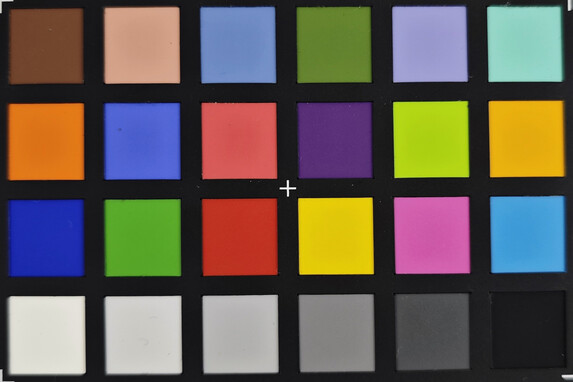
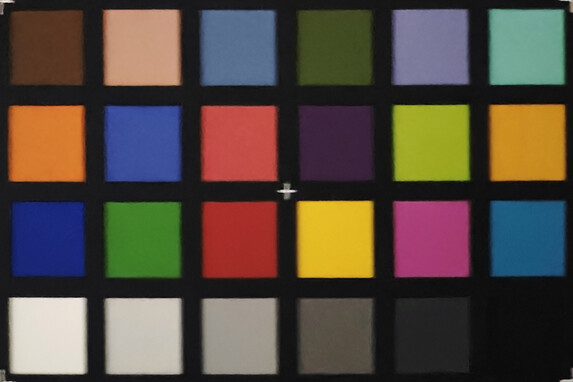
Accessories and Warranty - Xiaomi 13 Ultra with included charger
The box of the Xiaomi 13 Ultra includes a modular 90-watt charger, a protective case, a USB cable, and a protective screen cover. Optionally, a camera kit together with a protective cover with an integrated handle, a camera trigger, and an E67 filter thread is also available for hobby photographers, allowing them to use ND and Pol filters. In addition, TradingShenzhen, who provided our test unit, also included an EU adapter for the charger and a USB OTG adapter in the box of our Chinese version.
The warranty for the Xiaomi smartphone covers 12 months. With our imported unit from TradingShenzhen, you also have the option to send the smartphone to a German address in case of a warranty claim.
Input Devices and Operation - Xiaomi 13 Ultra with FaceUnlock
The Xiaomi flagship offers an excellent touchscreen with a 120 Hz refresh rate and 240 Hz scanning rate, ensuring that inputs are quickly and accurately implemented. The vibration motor delivers crisp haptic feedback, operating at a high quality level.
For biometric security, an optical fingerprint sensor is integrated in the display. Our fingers are recognized quickly and reliably. Less secure but just as fast is the 2D face recognition in daylight conditions. Under worse light conditions, this unlocking method succeeds less often.
Display - Xiaomi smartphone with AMOLED
Xiaomi not only looked for a partner to cooperate on the cameras but also in the area of the display. The large 6.73-inch LTPO panel was developed in cooperation with TCL and offers a WQHD+ resolution with a dynamic refresh rate of 1 Hz to 120 Hz. We can also confirm these values from the reading of the system data. An RGBG matrix consisting of one red, one blue, and two green LEDs is used here.
The display sides are rounded. According to the manufacturer, the panel is supposed to reach an incredible maximum brightness of 2,600 cd/m², but we are unable to confirm this in our measurements. With a pure white display with activated brightness sensor, the display of the Xiaomi 13 Ultra reaches more than 1,400 cd/m², which is an excellent value. With an even distribution of light and dark areas (APL18), we are able to get up to 1,628 cd/m² from the panel, which is also an excellent result, even though it is considerably lower than the top level advertised by the manufacturer.
| |||||||||||||||||||||||||
Brightness Distribution: 89 %
Center on Battery: 1357 cd/m²
Contrast: ∞:1 (Black: 0 cd/m²)
ΔE ColorChecker Calman: 1.1 | ∀{0.5-29.43 Ø4.78}
ΔE Greyscale Calman: 2 | ∀{0.09-98 Ø5}
97.4% sRGB (Calman 2D)
Gamma: 2.2
CCT: 6366 K
| Xiaomi 13 Ultra AMOLED, 3200x1440, 6.7" | Xiaomi 12S Ultra OLED, 3200x1440, 6.7" | Samsung Galaxy S23 Ultra Dynamic AMOLED 2x, 3080x1440, 6.8" | Google Pixel 7 Pro OLED, 3120x1440, 6.7" | Motorola Edge 40 Pro P-OLED, 2400x1080, 6.7" | |
|---|---|---|---|---|---|
| Screen | -12% | -31% | 8% | -8% | |
| Brightness middle (cd/m²) | 1357 | 831 -39% | 1117 -18% | 1022 -25% | 1056 -22% |
| Brightness (cd/m²) | 1340 | 807 -40% | 1133 -15% | 1025 -24% | 1055 -21% |
| Brightness Distribution (%) | 89 | 91 2% | 97 9% | 99 11% | 92 3% |
| Black Level * (cd/m²) | |||||
| Colorchecker dE 2000 * | 1.1 | 1.03 6% | 2.2 -100% | 0.9 18% | 1.28 -16% |
| Colorchecker dE 2000 max. * | 2.7 | 3.06 -13% | 3.9 -44% | 2.1 22% | 2.85 -6% |
| Greyscale dE 2000 * | 2 | 1.8 10% | 2.3 -15% | 1.1 45% | 1.7 15% |
| Gamma | 2.2 100% | 2.233 99% | 2.37 93% | 2.22 99% | 2.206 100% |
| CCT | 6366 102% | 6396 102% | 6572 99% | 6650 98% | 6320 103% |
* ... smaller is better
Like its competitors, the OLED panel of the Xiaomi flagship is also not free from the flickering due to PWM. Our measurements result in a constant frequency of 120 Hz with some brief outliers upwards. Even though this initially sounds like an uncomfortably low frequency, we should still consider this easy on the eyes due to the flat pulse amplitude. However, the manufacturer itself speaks about a very high PWM frequency of 1920 Hz, which should be much more comfortable particularly for sensitive users. We cannot conclusively clarify whether the cause for this difference is to be found in our equipment or whether this automatic DC dimming-like mode was just not active.
Screen Flickering / PWM (Pulse-Width Modulation)
| Screen flickering / PWM detected | 120 Hz | ||
The display backlight flickers at 120 Hz (worst case, e.g., utilizing PWM) . The frequency of 120 Hz is very low, so the flickering may cause eyestrain and headaches after extended use. In comparison: 53 % of all tested devices do not use PWM to dim the display. If PWM was detected, an average of 8101 (minimum: 5 - maximum: 343500) Hz was measured. | |||
Series of measurements at a fixed zoom level and various brightness settings
We evaluate the color calibration of the HDR10+ and Dolby Vision certified AMOLED panel with the CalMAN analysis software and a photo spectrometer. In the "Original" profile, the sRGB color space is targeted and covered almost completely. We get very low color deviations here, and the measured DeltaE values also show very small deviations in the grayscale. The Xiaomi 13 Ultra also offers the option to target the larger DCI-P3 color space, but the deviations in the color reproduction turn out slightly higher here, as you can expect.
The flagship from the Chinese manufacturer offers three color profiles as well as an "Advanced" mode, allowing you to adjust the color space and color temperature and even some individual parameters such as saturation. In addition, you can use the brightness sensor for automatic adjustment of the color reproduction.
Display Response Times
| ↔ Response Time Black to White | ||
|---|---|---|
| 1.04 ms ... rise ↗ and fall ↘ combined | ↗ 0.5365 ms rise | |
| ↘ 0.508 ms fall | ||
| The screen shows very fast response rates in our tests and should be very well suited for fast-paced gaming. In comparison, all tested devices range from 0.1 (minimum) to 240 (maximum) ms. » 4 % of all devices are better. This means that the measured response time is better than the average of all tested devices (20.2 ms). | ||
| ↔ Response Time 50% Grey to 80% Grey | ||
| 1.02 ms ... rise ↗ and fall ↘ combined | ↗ 0.4945 ms rise | |
| ↘ 0.5275 ms fall | ||
| The screen shows very fast response rates in our tests and should be very well suited for fast-paced gaming. In comparison, all tested devices range from 0.165 (minimum) to 636 (maximum) ms. » 3 % of all devices are better. This means that the measured response time is better than the average of all tested devices (31.6 ms). | ||
Outdoors, the Xiaomi 13 Ultra leaves an excellent impression. The brightness sensor responds quickly to changing light conditions, and thanks to the extreme brightness, even bright sunlight is unable to impede the readability of the OLED panel. The viewing angle stability is also very good, and the brightness level hardly decreases even from very steep viewing angles.
Performance - Xiaomi smartphone with Qualcomm SoC
Like the Xiaomi 13 Pro, the Ultra model also uses the Snapdragon 8 Gen 2, which presents itself very well in our benchmarks. In Geekbench 6, the Qualcomm SoC delivers even higher values than the Galaxy S23 Ultra, which uses the Snapdragon 8 Gen 2 for Galaxy that has a slightly higher clock speed. Particularly the multicore value turns out very high with the Xiaomi smartphone.
| UL Procyon AI Inference for Android - Overall Score NNAPI | |
| Xiaomi 12S Ultra | |
| Google Pixel 7 Pro | |
| Average of class Smartphone (3769 - 81594, n=135, last 2 years) | |
| Samsung Galaxy S23 Ultra | |
| Motorola Edge 40 Pro | |
| Xiaomi 13 Ultra | |
| Average Qualcomm Snapdragon 8 Gen 2 (11338 - 16880, n=21) | |
The integrated Adreno 740 handles the graphics acceleration. In GFXbench, the Xiaomi 13 Ultra reaches very strong values at times (for example in the Manhattan tests), but it mostly performs at the level of a Galaxy S23 Ultra. In the Wildlife tests, the Xiaomi flagship is also able to keep up with the Snapdragon 8 Gen 2 for Galaxy.
GFXBench (DX / GLBenchmark) 2.7: T-Rex Onscreen | 1920x1080 T-Rex Offscreen
GFXBench 3.0: on screen Manhattan Onscreen OGL | 1920x1080 1080p Manhattan Offscreen
GFXBench 3.1: on screen Manhattan ES 3.1 Onscreen | 1920x1080 Manhattan ES 3.1 Offscreen
GFXBench: on screen Car Chase Onscreen | 1920x1080 Car Chase Offscreen | on screen Aztec Ruins High Tier Onscreen | 2560x1440 Aztec Ruins High Tier Offscreen | on screen Aztec Ruins Normal Tier Onscreen | 1920x1080 Aztec Ruins Normal Tier Offscreen | 3840x2160 4K Aztec Ruins High Tier Offscreen
| 3DMark / Wild Life Extreme Unlimited | |
| Samsung Galaxy S23 Ultra | |
| Xiaomi 13 Ultra | |
| Motorola Edge 40 Pro | |
| Xiaomi 12S Ultra | |
| Google Pixel 7 Pro | |
| 3DMark / Wild Life Extreme | |
| Samsung Galaxy S23 Ultra | |
| Xiaomi 13 Ultra | |
| Motorola Edge 40 Pro | |
| Xiaomi 12S Ultra | |
| Google Pixel 7 Pro | |
| 3DMark / Wild Life Unlimited Score | |
| Samsung Galaxy S23 Ultra | |
| Xiaomi 13 Ultra | |
| Xiaomi 12S Ultra | |
| Google Pixel 7 Pro | |
| GFXBench (DX / GLBenchmark) 2.7 / T-Rex Onscreen | |
| Google Pixel 7 Pro | |
| Samsung Galaxy S23 Ultra | |
| Motorola Edge 40 Pro | |
| Xiaomi 13 Ultra | |
| Xiaomi 12S Ultra | |
| GFXBench (DX / GLBenchmark) 2.7 / T-Rex Offscreen | |
| Samsung Galaxy S23 Ultra | |
| Xiaomi 13 Ultra | |
| Motorola Edge 40 Pro | |
| Xiaomi 12S Ultra | |
| Google Pixel 7 Pro | |
| GFXBench 3.0 / Manhattan Onscreen OGL | |
| Motorola Edge 40 Pro | |
| Xiaomi 13 Ultra | |
| Samsung Galaxy S23 Ultra | |
| Xiaomi 12S Ultra | |
| Google Pixel 7 Pro | |
| GFXBench 3.0 / 1080p Manhattan Offscreen | |
| Xiaomi 13 Ultra | |
| Motorola Edge 40 Pro | |
| Samsung Galaxy S23 Ultra | |
| Xiaomi 12S Ultra | |
| Google Pixel 7 Pro | |
| GFXBench 3.1 / Manhattan ES 3.1 Onscreen | |
| Motorola Edge 40 Pro | |
| Xiaomi 13 Ultra | |
| Xiaomi 12S Ultra | |
| Samsung Galaxy S23 Ultra | |
| Google Pixel 7 Pro | |
| GFXBench 3.1 / Manhattan ES 3.1 Offscreen | |
| Xiaomi 13 Ultra | |
| Motorola Edge 40 Pro | |
| Samsung Galaxy S23 Ultra | |
| Xiaomi 12S Ultra | |
| Google Pixel 7 Pro | |
| GFXBench / Car Chase Onscreen | |
| Motorola Edge 40 Pro | |
| Xiaomi 12S Ultra | |
| Samsung Galaxy S23 Ultra | |
| Xiaomi 13 Ultra | |
| Google Pixel 7 Pro | |
| GFXBench / Car Chase Offscreen | |
| Xiaomi 13 Ultra | |
| Motorola Edge 40 Pro | |
| Samsung Galaxy S23 Ultra | |
| Xiaomi 12S Ultra | |
| Google Pixel 7 Pro | |
| GFXBench / Aztec Ruins High Tier Onscreen | |
| Motorola Edge 40 Pro | |
| Xiaomi 12S Ultra | |
| Samsung Galaxy S23 Ultra | |
| Xiaomi 13 Ultra | |
| Google Pixel 7 Pro | |
| GFXBench / Aztec Ruins High Tier Offscreen | |
| Samsung Galaxy S23 Ultra | |
| Xiaomi 13 Ultra | |
| Motorola Edge 40 Pro | |
| Xiaomi 12S Ultra | |
| Google Pixel 7 Pro | |
| GFXBench / Aztec Ruins Normal Tier Onscreen | |
| Motorola Edge 40 Pro | |
| Xiaomi 12S Ultra | |
| Samsung Galaxy S23 Ultra | |
| Xiaomi 13 Ultra | |
| Google Pixel 7 Pro | |
| GFXBench / Aztec Ruins Normal Tier Offscreen | |
| Samsung Galaxy S23 Ultra | |
| Xiaomi 13 Ultra | |
| Motorola Edge 40 Pro | |
| Xiaomi 12S Ultra | |
| Google Pixel 7 Pro | |
| GFXBench / 4K Aztec Ruins High Tier Offscreen | |
| Samsung Galaxy S23 Ultra | |
| Xiaomi 13 Ultra | |
| Motorola Edge 40 Pro | |
| Xiaomi 12S Ultra | |
| Google Pixel 7 Pro | |
In the browser benchmarks, the Xiaomi 13 Ultra jumps ahead significantly compared to the predecessor, distancing itself from the competitors. In everyday operation, surfing in the Chrome browser feels very smooth.
| Jetstream 2 - 2.0 Total Score | |
| Xiaomi 13 Ultra (Chrome 113) | |
| Samsung Galaxy S23 Ultra (Chrome 109) | |
| Average of class Smartphone (23.8 - 387, n=149, last 2 years) | |
| Average Qualcomm Snapdragon 8 Gen 2 (62.7 - 179.2, n=23) | |
| Xiaomi 12S Ultra (Chrome 104) | |
| Motorola Edge 40 Pro (Chrome 112) | |
| Google Pixel 7 Pro (Chrome 106) | |
| Speedometer 2.0 - Result 2.0 | |
| Average of class Smartphone (15.2 - 643, n=122, last 2 years) | |
| Xiaomi 13 Ultra (Chrome 113) | |
| Samsung Galaxy S23 Ultra (Chrome 109) | |
| Average Qualcomm Snapdragon 8 Gen 2 (62.9 - 225, n=18) | |
| Google Pixel 7 Pro (Chrome 106) | |
| Xiaomi 12S Ultra (Chrome 104) | |
| Motorola Edge 40 Pro (Chome 112) | |
| WebXPRT 4 - Overall | |
| Average of class Smartphone (27 - 306, n=145, last 2 years) | |
| Samsung Galaxy S23 Ultra (Chrome 110) | |
| Xiaomi 13 Ultra (Chrome 113) | |
| Average Qualcomm Snapdragon 8 Gen 2 (28 - 183, n=22) | |
| Xiaomi 12S Ultra (Chrome 104) | |
| Motorola Edge 40 Pro (Chrome 112) | |
| Google Pixel 7 Pro (Chrome 106) | |
| WebXPRT 3 - Overall | |
| Xiaomi 13 Ultra (Chrome 113) | |
| Average Qualcomm Snapdragon 8 Gen 2 (115 - 238, n=11) | |
| Average of class Smartphone (38 - 380, n=31, last 2 years) | |
| Motorola Edge 40 Pro (Chrome 112) | |
| Xiaomi 12S Ultra (Chrome 104) | |
| Google Pixel 7 Pro (Chrome 106) | |
| Octane V2 - Total Score | |
| Xiaomi 13 Ultra (Chrome 113) | |
| Samsung Galaxy S23 Ultra (Chrome 109) | |
| Average of class Smartphone (2228 - 121337, n=197, last 2 years) | |
| Average Qualcomm Snapdragon 8 Gen 2 (19870 - 65418, n=25) | |
| Google Pixel 7 Pro (Chrome 106) | |
| Xiaomi 12S Ultra (Chrome 104) | |
| Motorola Edge 40 Pro (Chrome 112) | |
| Mozilla Kraken 1.1 - Total | |
| Motorola Edge 40 Pro (Chrome 112) | |
| Average of class Smartphone (257 - 28190, n=154, last 2 years) | |
| Xiaomi 12S Ultra (Chrome 104) | |
| Average Qualcomm Snapdragon 8 Gen 2 (602 - 1837, n=22) | |
| Google Pixel 7 Pro (Chrome 106) | |
| Samsung Galaxy S23 Ultra (Chrome 109) | |
| Xiaomi 13 Ultra (Chrome 113) | |
* ... smaller is better
The fast UFS 4.0 storage ensures very high values above 4,000 MB/s. Only when reading and writing small data blocks, the performance of the Xiaomi flagship is slightly weaker.
| Xiaomi 13 Ultra | Xiaomi 12S Ultra | Samsung Galaxy S23 Ultra | Google Pixel 7 Pro | Motorola Edge 40 Pro | Average 512 GB UFS 4.0 Flash | Average of class Smartphone | |
|---|---|---|---|---|---|---|---|
| AndroBench 3-5 | -33% | -33% | -59% | -1% | -5% | -37% | |
| Sequential Read 256KB (MB/s) | 4511.82 | 1963.45 -56% | 3426.56 -24% | 1346.78 -70% | 3434.4 -24% | 3689 ? -18% | 2228 ? -51% |
| Sequential Write 256KB (MB/s) | 2878.39 | 1475.43 -49% | 1389.84 -52% | 874.73 -70% | 2887.4 0% | 3092 ? 7% | 1852 ? -36% |
| Random Read 4KB (MB/s) | 398.87 | 309.21 -22% | 449.77 13% | 219.01 -45% | 451.3 13% | 385 ? -3% | 296 ? -26% |
| Random Write 4KB (MB/s) | 507.27 | 489.58 -3% | 152.92 -70% | 253.18 -50% | 539 6% | 474 ? -7% | 339 ? -33% |
Games - Xiaomi 13 Ultra manages only 60 fps
In order to evaluate the graphics power of the Adreno GPU in everyday operation, we are looking at two games using the software from our partner GameBench. Even though the hardware is very powerful, we only get a meager 60 fps in the arena shooter that theoretically supports the full 120 Hz of the display used here. It is not clear why the frame rate is so low here, since this is not the result of thermal problems. Probably the reason lies in a lack of optimizations and/or driver adjustments. In PUBG Mobile, the typical 60 fps are possible in the HD setting, and at the highest detail level (UHD), the flagship reaches a constant 40 fps.
Emissions - The Xiaomi smartphone gets warm
Temperatures
While the surface temperatures of the Xiaomi 13 Ultra are very low during idle operation, things unfortunately look different under constant load, where we measure more than 48 °C (118 °F) as the top value. However, in the comparison with the maximum temperature of 33 °C (91 °F) that we measured in the Pro model, we should also mention that we are now using the Burnout benchmark instead of the stability test to measure the temperatures under load. An exact comparison of the temperatures is therefore not possible anymore.
The specially developed Mi IceLoop heat dissipation technology of the Xiaomi 13 Ultra is also challenged with the Wildlife stress test of 3DMark. At about 90%, the Xiaomi 13 Ultra is one of the most constant smartphones with the Snapdragon 8 Gen 2, now throttling significantly less than the Galaxy S23 Ultra or Oppo Find X6 Pro.
(-) The maximum temperature on the upper side is 48.4 °C / 119 F, compared to the average of 35.2 °C / 95 F, ranging from 21.9 to 247 °C for the class Smartphone.
(-) The bottom heats up to a maximum of 46.8 °C / 116 F, compared to the average of 34 °C / 93 F
(+) In idle usage, the average temperature for the upper side is 30.1 °C / 86 F, compared to the device average of 32.9 °C / 91 F.
3DMark Wildlife Stress Test
| 3DMark | |
| Wild Life Stress Test Stability | |
| Xiaomi 13 Ultra | |
| Samsung Galaxy S23 Ultra | |
| Google Pixel 7 Pro | |
| Motorola Edge 40 Pro | |
| Xiaomi 12S Ultra | |
| Wild Life Extreme Stress Test | |
| Xiaomi 13 Ultra | |
| Xiaomi 12S Ultra | |
| Google Pixel 7 Pro | |
| Motorola Edge 40 Pro | |
| Samsung Galaxy S23 Ultra | |
Speakers
The two Dolby Atmos certified speakers of the Xiaomi 13 Ultra produce a balanced sound spectrum with even mids and even some lower frequency tones. But even the Xiaomi flagship is unable to deliver really low frequencies with present bass sounds, although it is one of the best smartphones in this regard.
Those who want to connect wired sound output devices have to use the USB-C port. For a wireless connection, the modern Bluetooth 5.3 is available. In terms of supported codecs, the Xiaomi 13 Ultra offers a wide selection including SBC, AAC, aptX, aptX HD, aptX Adaptive, aptX TWS+, LDAC, and LHDC V5.
Xiaomi 13 Ultra audio analysis
(+) | speakers can play relatively loud (89.5 dB)
Bass 100 - 315 Hz
(-) | nearly no bass - on average 22.8% lower than median
(+) | bass is linear (6.1% delta to prev. frequency)
Mids 400 - 2000 Hz
(+) | balanced mids - only 3.6% away from median
(+) | mids are linear (4.8% delta to prev. frequency)
Highs 2 - 16 kHz
(±) | higher highs - on average 5.7% higher than median
(+) | highs are linear (4% delta to prev. frequency)
Overall 100 - 16.000 Hz
(±) | linearity of overall sound is average (16.3% difference to median)
Compared to same class
» 6% of all tested devices in this class were better, 5% similar, 89% worse
» The best had a delta of 11%, average was 35%, worst was 134%
Compared to all devices tested
» 26% of all tested devices were better, 6% similar, 69% worse
» The best had a delta of 4%, average was 24%, worst was 134%
Samsung Galaxy S23 Ultra audio analysis
(+) | speakers can play relatively loud (91.8 dB)
Bass 100 - 315 Hz
(-) | nearly no bass - on average 19.4% lower than median
(+) | bass is linear (5.1% delta to prev. frequency)
Mids 400 - 2000 Hz
(±) | reduced mids - on average 5.1% lower than median
(+) | mids are linear (4.2% delta to prev. frequency)
Highs 2 - 16 kHz
(±) | higher highs - on average 6.2% higher than median
(+) | highs are linear (2.5% delta to prev. frequency)
Overall 100 - 16.000 Hz
(±) | linearity of overall sound is average (15.6% difference to median)
Compared to same class
» 4% of all tested devices in this class were better, 3% similar, 93% worse
» The best had a delta of 11%, average was 35%, worst was 134%
Compared to all devices tested
» 23% of all tested devices were better, 4% similar, 73% worse
» The best had a delta of 4%, average was 24%, worst was 134%
Battery Life - Xiaomi 13 Ultra with Fast Charging
Power Consumption
The 5,000-mAh battery can optionally be charged using either USB-C at up to 90 watts or wirelessly at a maximum of 50 watts. Using the included 90-watt charger, it takes about 40 minutes to completely recharge the smartphone. Using a corresponding Wireless Charger Station, it takes 49 minutes according to the manufacturer. In addition to the proprietary MI FC 2.0 quick charging technology, the premium smartphone also supports the PD 3.0 fast charging protocol or QuickCharge 4.
The power consumption under load is exemplary, but during idle operation, the Galaxy S23 Ultra shows itself slightly more efficient than the Xiaomi flagship.
| Off / Standby | |
| Idle | |
| Load |
|
Key:
min: | |
| Xiaomi 13 Ultra 5000 mAh | Xiaomi 12S Ultra 4860 mAh | Samsung Galaxy S23 Ultra 5000 mAh | Google Pixel 7 Pro 5000 mAh | Motorola Edge 40 Pro 4600 mAh | Average Qualcomm Snapdragon 8 Gen 2 | Average of class Smartphone | |
|---|---|---|---|---|---|---|---|
| Power Consumption | 8% | 2% | 2% | -49% | -49% | -38% | |
| Idle Minimum * (Watt) | 0.86 | 0.9 -5% | 0.9 -5% | 0.78 9% | 0.7 19% | 1.036 ? -20% | 0.842 ? 2% |
| Idle Average * (Watt) | 1.53 | 1 35% | 1.05 31% | 1.61 -5% | 0.8 48% | 1.766 ? -15% | 1.439 ? 6% |
| Idle Maximum * (Watt) | 1.64 | 1.2 27% | 1.1 33% | 1.63 1% | 1.3 21% | 1.94 ? -18% | 1.624 ? 1% |
| Load Average * (Watt) | 3.12 | 3.5 -12% | 3.99 -28% | 3.29 -5% | 10 -221% | 7.22 ? -131% | 7.03 ? -125% |
| Load Maximum * (Watt) | 6.5 | 6.9 -6% | 7.82 -20% | 6.01 8% | 13.7 -111% | 10.4 ? -60% | 11.3 ? -74% |
* ... smaller is better
Power Consumption: Geekbench (150 cd/m²)
Power Consumption: GFXBench (150 cd/m²)
Battery Life
The battery life of the Xiaomi 13 Ultra is convincing. We use the full WQHD+ resolution and 120 Hz as the refresh rate to evaluate this. The Xiaomi flagship doesn't show the typically elevated power consumption of the communication modules during the constant loop of our Big Buck Bunny test video. With about 18 hours, the Xiaomi flagship lasts more than 2 hours longer than its predecessor in our WLAN battery test at an adjusted brightness of 150 cd/m².
| Xiaomi 13 Ultra 5000 mAh | Xiaomi 12S Ultra 4860 mAh | Samsung Galaxy S23 Ultra 5000 mAh | Google Pixel 7 Pro 5000 mAh | Motorola Edge 40 Pro 4600 mAh | |
|---|---|---|---|---|---|
| Battery runtime | 3% | 29% | -18% | 5% | |
| Reader / Idle (h) | 28.8 | 29.4 2% | 35.7 24% | 20.2 -30% | 35 22% |
| H.264 (h) | 16.8 | 18.5 10% | 25.7 53% | 20.2 20% | 17.7 5% |
| WiFi v1.3 (h) | 17.8 | 15.9 -11% | 18.3 3% | 11.3 -37% | 16.4 -8% |
| Load (h) | 5 | 5.5 10% | 6.7 34% | 3.8 -24% | 5 0% |
Pros
Cons
Verdict on the Xiaomi 13 Ultra
With the exception of some smaller critique points, Xiaomi delivers one of the best smartphones of the year with its 13 Ultra. The flagship smartphone from the Chinese manufacturer offers an extensive list of equipment, a massive performance, and a high quality casing made of vegan leather and metal. The Xiaomi smartphone achieves a surprisingly clear distance from the Snapdragon 8 Gen 2 competitors in terms of SoC throttling. The 13 Ultra throttles significantly less than for example an Honor Magic 5 Pro or Galaxy S23 Ultra with a similar performance development.
The camera package around the very large Sony image sensor delivers really good results in everyday operation. With the variable aperture and an extensive focal length range, the Xiaomi 13 Ultra is excellently prepared for most scenarios. We might again criticize the low resolution of videos recorded with the selfie camera, and it continues to remain a mystery why the Chinese manufacturer is unable to offer a 4K option with the 32-MP lens. Such deficits might hardly make any difference in everyday operation for most users. Those who still like to create UHD selfie recordings for vlogging might find the appropriate flagship alternative in the Galaxy S23 Ultra or the Pixel 7 Pro.
Although the Xiaomi 13 Ultra is a costly affair, buyers of the flagship smartphone will get a lot for their money.
The discrepancy between the manufacturer specifications and our measurements of the display brightness deserves some critique for sure. The panel that is specified with 2,600 nits doesn't even come close to the advertised top value, and at 1,700 cd/m² it remains significantly below its advertised capabilities. In addition, we are repeatedly mystified why current high-end smartphones are unable (or not allowed) to reach their full potential in HFR gaming - and with the constancy of a Xiaomi 13 Ultra this becomes even more of a mystery.
Price and Availability
The Xiaomi 13 Ultra is currently available as an import device from TradingShenzhen starting from around $1,185. We expect the prices for the global version to start from about 1,500 Euros (~$1,658).
Xiaomi 13 Ultra
- 05/22/2023 v7 (old)
Marcus Herbrich
Transparency
The selection of devices to be reviewed is made by our editorial team. The test sample was provided to the author as a loan by the manufacturer or retailer for the purpose of this review. The lender had no influence on this review, nor did the manufacturer receive a copy of this review before publication. There was no obligation to publish this review. As an independent media company, Notebookcheck is not subjected to the authority of manufacturers, retailers or publishers.
This is how Notebookcheck is testing
Every year, Notebookcheck independently reviews hundreds of laptops and smartphones using standardized procedures to ensure that all results are comparable. We have continuously developed our test methods for around 20 years and set industry standards in the process. In our test labs, high-quality measuring equipment is utilized by experienced technicians and editors. These tests involve a multi-stage validation process. Our complex rating system is based on hundreds of well-founded measurements and benchmarks, which maintains objectivity. Further information on our test methods can be found here.





